You may have heard the saying, “Strength is a skill.”
But is it really? And what implications does this have for you and your training?
I made up this scale that can be seen below and we will go into depth about what it means. It is a simple scale with a x and y axis (surely, you remember this little bit from geometry). On one axis is strength and on another is skill.
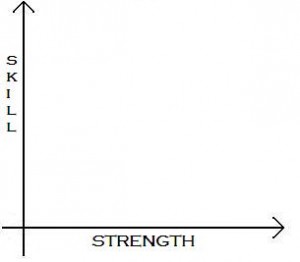 Just to be clear we are using strength as a major term to cover maximum as well as endurance strength.
Just to be clear we are using strength as a major term to cover maximum as well as endurance strength.
Every physical feat is going to fit somewhere on this scale. Since there is no negative skill or strength you only need the positive sides of the chart which is shown.
Now here are some examples to see what this means. Playing a piano is a highly technical skill. Obviously it is not going to take any strength. I guess it will take some endurance in the hands so it will not rate zero on the strength scale but the skill level is way high. Playing the piano would be here.
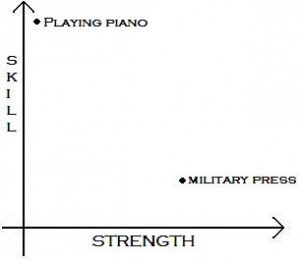
Lets take the standing military press next. This is a big time strength movement. But there is skill involved. This is really where that saying above comes into play. By increasing your skill in the movement you will be able to put up a bigger weight. However, it is still not a highly skilled movement.
If you take an Olympic lift like the Jerk, you will find that this feat takes more skill but still rates very high on strength needed. A great example of this can be read about in The Mightiest Minister, Paul Anderson’s story. When he competed in the Olympics of 1956 he was able to put up huge numbers because he was so strong. He set a world record in the Jerk at 413.5 lbs. Other guys half his size have exceeded his numbers not with brute strength but by being so skilled in the lift. Tommy Kono was not as strong as Paul (and about half his size) yet he was able to put up 350 lbs. in the Jerk.
A favorite of mine is juggling kettlebells. This takes skill and was something I practiced a lot, so that I could do moves like the over-the-shoulder pass or under-the-legs flip. Doing these with a 16kg bell is easy for me. Since the bell is light it requires little strength (just the skill to be able to do the move). Doing the moves with a 32 kg bell proves much harder. The skill is there (perhaps degraded a bit from the different physics of a heavier bell) but my strength is not for many of the trickier moves. In this case it is the strength that is lacking, not the skill.
Another favorite is hand balancing. Some of the stunts are very high in the skill level but do not require so much strength. Others are opposite. In the first case we have just the basic handstand. It requires very little strength to actually hold yourself up. The skill is all in balancing. Taking this a step further you have the one hand handstand. A little more strength but a lot more skill is required. Meanwhile stunts like presses take strength but little skill. The planche (which is sort of like holding a pushup except only your hands touch the ground) takes great strength. Skill for this trick is still high.
Bending steel is an interesting case. You need a certain level of skill to be able to do it well. Proper instruction will bring your skill level up high enough where you can perform the feat. From then on you must build your strength. I would say that most of the classic strongman feats (such as phonebook tearing and card tearing) are the same way.
What does all this mean and how can you apply it?
Every feat will have a basic starting point as far as strength and skill required. Realize that you can make progress (how ever you are measuring it) by increasing your strength or skill.
For example lets take the normal pushup. Sad to say that most people are doing these wrong . By learning certain techniques you can immediately increase your numbers. Other techniques will change your form and in the beginning drop your numbers. However, after some practice (i.e. building the skill) at these you will surpass your original max.
Then again you can just do pushups in a progressive manner from workout to workout and not worry about your skill level. If you meet all the necessary factors for improvement you will get stronger. Once again you will be able to perform more pushups.
The end result of each path is the same. The real beauty comes in doing both at once. This can make big differences down the road.
Now you may not be able to try to increase your strength and skill at the same exact time, meaning in the same workout or exercise. You don’t perfect your technique in the Jerk by trying to add more and more weight. No, you work with a light enough weight (even going so far as using a broomstick) so that you can do it perfectly.
What you can do is two different workouts. One where your focus is technique and improving the skill and the other is trying to get stronger. Of course in the strength workout you do your best to maintain the technique.
Another implication is in how you decide to go after certain feats. Realize that feats that take more skill may see better results if you practiced them differently then less technical feats. To increase your skill level you want to be as fresh as possible and in an optimal mind state. Meanwhile improving your strength will require hard work. It still takes a optimal mind state for best effects, but possibly of a different kind.
I suggest you use this chart to get an new look on your training and better help you to understand what you are going for.
Find out more about Practicing Strength and Movement in my book by the same name.

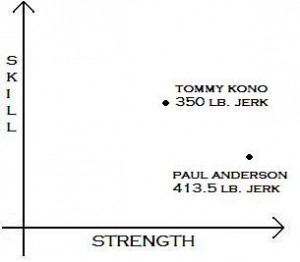
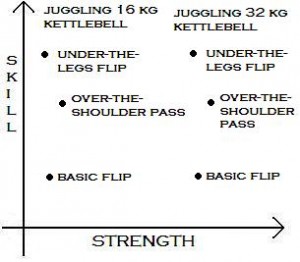
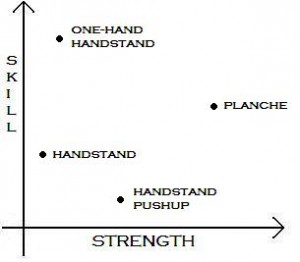
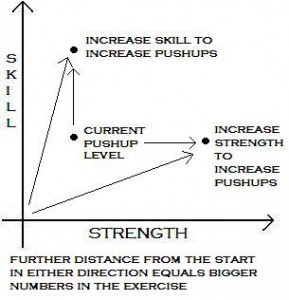

Comments
Thanks for this excellent article!